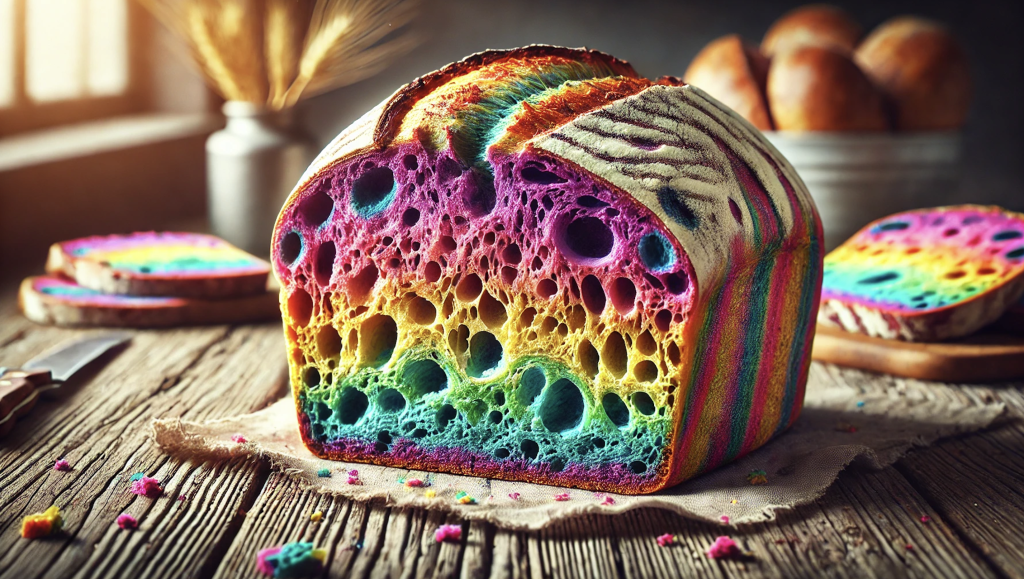Are you tired of the traditional beige-toned sourdough bread and want to add a touch of color and fun to your baking? Fear not, we have just the thing for you! This article is dedicated to those who want to take a creative leap and naturally dye their sourdough bread using ingredients found in their own kitchen. No artificial food coloring is required!
The world is becoming increasingly concerned with natural food sources and decreasing the use of artificial ingredients in our diets. In line with this trend, many bakers are exploring the use of natural food-based dyes derived from fruits, vegetables, and unique types of flour. But why and how does this work?
The ‘Why’
There are three main reasons why bakers might opt for naturally colored sourdough.
- Visual Appeal: The first, and perhaps most obvious reason, is for the aesthetic value. Naturally dyed bread can create a stunning visual impact, making your loaves the talk of the town. Imagine serving a vibrant purple loaf at your next get-together!
- Nutrition: Many natural colorants also come with additional health benefits. For example, beetroot, which imparts a beautiful pink color, is high in fiber, vitamins, and minerals.
- Novelty and Creativity: Baking is as much an art as it is a science. Adding natural colors to your bread allows for creativity and fun in the kitchen, making the process even more enjoyable.
The ‘How’
Creating colorful bread might seem daunting, but it’s easier than you might think. Here are a few ingredients that can help add color to your sourdough:
Fruits & Vegetables
These can be used fresh, cooked, or in powder form.
- Red/Pink: Beets are a perfect choice for achieving pink to red hues. Incorporate cooked and puréed beetroot or beetroot powder into your dough.
- Green: Spinach, matcha, or spirulina can give your bread a lively green color. Blend fresh spinach leaves and add the purée to your dough, or use matcha or spirulina powder.
- Purple: Purple sweet potatoes or blueberries can result in a lovely purple color. Purée cooked purple sweet potatoes or fresh blueberries and add them into your dough.
Unique Types of Flour
Different types of flour can also change the color of your sourdough.
- Blue: Blue corn flour, made from finely ground blue corn, can produce a blue-grey bread.
- Brown: Rye or whole wheat flour can darken your dough for a rich brown color.
- Black: Charcoal or black sesame flour can give your sourdough a deep, dark hue.
Remember, when using these natural colorants, it’s crucial to consider how they might affect your dough’s hydration and fermentation times. Additionally, the final color may not be as vivid as with artificial food coloring, but the subtle natural hues and the satisfaction of baking with all-natural ingredients make it all worthwhile.
With a bit of imagination and trial and error, you can create your own rainbow of sourdough loaves, each with its unique look and taste. So why not roll up your sleeves, get creative, and start painting with dough!
What Ingredients Add Colour to Sourdough Bread?
- Red Beet Powder: Made from dehydrated beets, this powder offers a vibrant pink to red hue and subtly sweet flavor.
- Carrot Powder: This ingredient can add a bright orange color to your dough and also infuse it with the sweet and earthy flavor of carrots.
- Pumpkin Puree: An orange pulp from cooked pumpkin, this ingredient can add a mild orange tint to your dough.
- Turmeric: A staple in many pantries, turmeric can lend your sourdough a sunny, yellow color. Use sparingly to avoid overtaking the flavor.
- Spinach Powder: This finely ground dehydrated spinach will turn your dough green and adds a healthy dose of iron.
- Matcha Powder: A fine, bright green tea powder from Japan, matcha adds a deep green color and a unique flavor.
- Spirulina Powder: This superfood is derived from blue-green algae and adds a striking blue-green hue to your dough.
- Blue Cornmeal: This specialty flour, made from blue corn, gives a blue-grey color to your dough. The flavor profile is similar to traditional cornmeal.
- Blueberry Powder: Made from freeze-dried blueberries, this powder adds a beautiful purple color and a hint of sweet-tart flavor.
- Purple Sweet Potato Powder: This ingredient gives your dough a vibrant purple color and subtly sweet flavor.
- Rye Flour: While this doesn’t add a vibrant color, it can darken your dough to a rich, warm brown. The flavor is distinct and hearty.
- Whole Wheat Flour: Similar to rye, whole wheat flour deepens the color of your dough to a toasty brown.
- Black Sesame Flour: This ingredient is made from finely ground black sesame seeds and adds a dark, almost black color to your dough with a slightly nutty flavor.
- Activated Charcoal Powder: Derived from burnt organic matter, activated charcoal will make your dough black. It doesn’t add much flavor but should be used sparingly due to its detoxifying properties.
- Cocoa Powder: This ingredient provides a deep brown color and adds a subtle chocolate flavor to your sourdough.
- Red Cabbage Juice: Interestingly, red cabbage juice can create a blue or purple tint depending on the pH of the dough.
- Red Wine: Using red wine instead of water can give your dough a purplish hue. It also adds a rich depth of flavor.
- Tomato Paste: This ingredient can lend your sourdough a light red or pinkish tone, plus a subtle tomato flavor.
- Paprika: This spice can give your bread a reddish-orange tint and a hint of smoky flavor.
- Cranberry Juice or Puree: Cranberries can provide a reddish-pink hue to your bread, along with a sweet-tart flavor.
- Orange or Tangerine Zest: Adding finely grated citrus peel to your dough can result in tiny specks of orange throughout your loaf.
- Green Tea Powder: Besides matcha, other green tea powders can also give your bread a subtle green tint and a delicate tea flavor.
- Moringa Powder: This superfood can give your bread a green color. It has a slightly sweet, grassy flavor.
- Buckwheat Flour: This flour gives your sourdough a unique grayish-blue tint. It has a strong, nutty flavor that pairs well with hearty bread.
- Black Cocoa Powder: This specialty cocoa powder is incredibly dark, giving your bread a nearly black color and a deep chocolate flavor.
- Coffee or Espresso Powder: Replacing some of the water with strong coffee or adding espresso powder will give your sourdough a deep brown color and a rich coffee flavor.
- Purple Carrot Juice or Puree: Purple carrots can add a purple to blue color to your bread, with a sweet, earthy flavor.
- Chlorophyll Extract: This dark green liquid can turn your dough green and is virtually flavorless.
Recipe Steps to Mix Ingredients Together?
- Prepare Your Starter: Start by preparing your sourdough starter as usual. Make sure it’s active and ready for baking.
- Choose Your Natural Colorant: Decide on the natural colorant you want to use. Be it a vegetable, fruit, spice, or unique flour, make sure it is finely processed into a purée, juice, or powder.
- Prepare the Colorant: For fruits and vegetables, you may need to cook and purée them before using. For spices or powders, you may need to dissolve them in a little warm water.
- Mixing: Add your chosen colorant to the wet ingredients of your recipe. This is typically when you’re mixing the water and starter. For powders like turmeric, matcha, beet, or blueberry powder, use a whisk to ensure there are no lumps.
- Adding the Flour: After the wet ingredients are well combined, add your flour. Be mindful that using a unique type of flour, like blue cornmeal or black sesame flour, will replace some of the regular flour in your recipe.
- Bulk Fermentation: After mixing, proceed with the bulk fermentation as per your sourdough recipe.
- Shaping and Proofing: Shape your dough and allow it to proof. Some colorants may slightly affect the proofing time.
- Baking: Bake as per your sourdough recipe. Be aware that some natural colorants may darken more than others in the oven.
Remember, the exact amount of colorant to use can vary greatly depending on the ingredient and the intensity of color you desire, so a little experimentation may be needed.
So, are you ready to brighten up your baking? Incorporating natural colorants into your sourdough is an exciting way to reinvent your loaves and surprise your family and friends. It’s not only about making your sourdough visually appealing; it’s also a fantastic method to add nutritional value and interesting flavors to your homemade bread. Most importantly, it’s about having fun in the process and breaking the boundaries of traditional baking. Here’s to a riot of color in your kitchen!





















